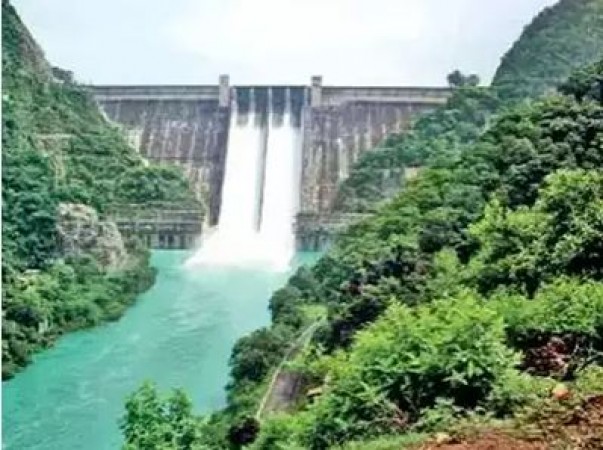
Bhakra Nangal Dam is a concrete gravity dam on the Satluj River in Bharkra Village, Bilaspur, and Himachal Pradesh. It is India’s second highest dam. The Dam forms the Govind sagar reservoir. The Bhakra Nangal Dam is one of India's most significant engineering marvels and a symbol of the country's prowess in water resource management. The dam stands as a testament to India's ability to harness water for irrigation, hydroelectric power generation, and flood control.
The idea of constructing a dam on the Sutlej River was first envisioned in the early 20th century. The concept gained momentum in the 1940s when the region faced severe droughts and floods, leading to widespread devastation and agricultural losses. To address these challenges and utilize the water potential of the Sutlej River, the Bhakra Nangal Dam project was initiated.
Also Read: Ponmudi: A Beautiful Hill Station That Offers the Pleasures of Nature
The length of the dam (measured from the road above it) is 518.25 m and the width is 9.1 m. Its reservoir known as "Gobind Sagar" stores up to 9.34 billion cubic meters of water. The 90 km long reservoir created by the Bhakra Dam is spread over an area of 168.35 km2. In terms of quantity of water, it is the third largest reservoir.
The construction of the Bhakra Nangal Dam began in 1948, following India's independence, and was completed in 1963. The project was a joint effort of the Central Water Commission, Government of India, and various engineering agencies, with the main aim of creating a multi-purpose reservoir.
Also Read: Ganga River Flows Above Danger Mark in Haridwar Amid Heavy Rainfall
Key Objectives and Benefits:
The Bhakra Nangal Dam serves several critical purposes, making it a vital lifeline for the region:
Hydroelectric Power Generation: One of the primary objectives of the project was to generate electricity. The dam's powerhouses, equipped with turbines, have a combined capacity of approximately 1,325 megawatts, providing a substantial portion of electricity to northern Indian states.
Irrigation: The reservoir created by the dam, known as the "Gobind Sagar," is a massive water body spread across Himachal Pradesh and Punjab. It serves as a major source of irrigation for the fertile plains of states, facilitating agricultural development and supporting farmers.
Drinking Water Supply: The dam's reservoir also supplies drinking water to numerous towns and cities in the region, ensuring a steady supply of clean water for domestic use.
Flood Control: The Nangal Dam helps regulate the flow of the Sutlej River during the monsoon season, preventing floods downstream and minimizing the risk of calamitous inundation.
Tourism and Recreation: The scenic beauty of the reservoir and the surrounding landscape has turned the Bhakra Nangal Dam into a popular tourist destination. Boating, fishing, and other water-based activities attract visitors from far and wide.
Also Read: Govind Ballah Pant Sagar: The Largest Artificial Lake
Socio-Economic Impact:
The Bhakra Nangal Dam project has had a profound socio-economic impact on the region and the country as a whole:
Agriculture and Food Security: The irrigation water provided by the dam has transformed vast arid lands into fertile agricultural fields. The increased agricultural output has significantly contributed to food security and economic growth in the region.
Industrial Growth: The availability of hydropower has stimulated industrial development in the states of Himachal Pradesh and Punjab. The surplus electricity generated is also supplied to neighboring states, fostering economic growth.
Employment Opportunities: The construction and maintenance of the dam have generated numerous employment opportunities, benefiting the local communities and labor force.
Infrastructure Development: The project has led to the creation of essential infrastructure like roads, housing, schools, and healthcare facilities, improving the overall quality of life in the region.
Also Read: Diabetes Mellitus: Types, Risk Factors, and Management
Environmental Considerations:
While the Bhakra Nangal Dam has brought substantial benefits, it has also raised environmental concerns:
Displacement of People: The construction of the dam resulted in the relocation of thousands of people living in the dam's catchment area, leading to social and cultural disruptions.
Ecological Impact: The dam's construction altered the natural flow of the Sutlej River and affected the local ecosystem, including the aquatic life and riparian habitats.
Sedimentation: Over time, sedimentation reduces the storage capacity of the reservoir, necessitating periodic dredging and management.
Also Read: Homi J. Bhabha: The Visionary Architect of India's Nuclear Program
The Bhakra Nangal Dam stands tall as a symbol of India's engineering prowess and its ability to manage water resources effectively. Its multi-faceted benefits in terms of power generation, irrigation, flood control, and tourism have significantly contributed to the economic development of the region and the nation. Despite facing challenges, the dam remains a crucial asset in India's journey towards sustainable development, providing livelihood opportunities and prosperity to millions of people. As the country continues to address the demands of a growing population and changing climate, the Bhakra Nangal Dam will undoubtedly play an essential role in shaping India's water future.
Also Read: Breaking News: Yamunotri, Badrinath Highway blocked by Falling Debris